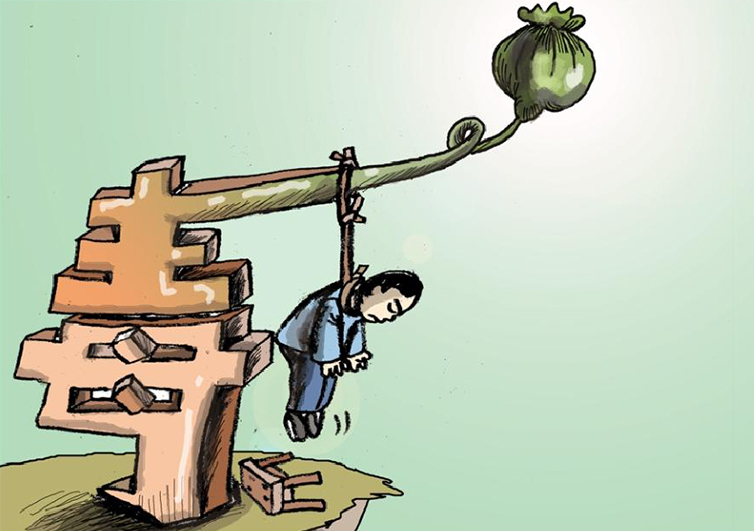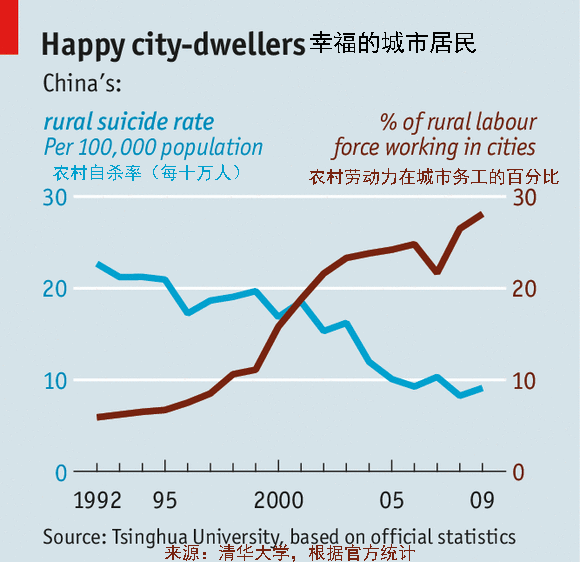
IN THE 1990s China had one of the highest suicide rates in the world. Young rural women in particular were killing themselves at an alarming rate. In recent years, however, China’s suicides have declined to among the lowest rates in the world.
在1990年代,中国的自杀率曾高居世界前列。特别是生活在农村的年轻女性,自杀率之高令人触目惊心。不过,近年来中国的自杀率大大下降,如今中国已然跻身自杀率最低的国家之列。
In 2002 the Lancet, a British medical journal, said there were 23.2 suicides per 100,000 people annually from 1995 to 1999. This year a report by a group of researchers from the University of Hong Kong found that had declined to an average annual rate of 9.8 per 100,000 for the years 2009-11, a 58% drop.
英国医学期刊《柳叶刀》2002 年的调研显示,1995至1999年,中国的年均自杀率为每十万人23.2例;今年,香港大学一个科研团队撰写的报告指出,2009-2011年间,中国的年平均自杀率下降到了每十万人9.8例,降幅达到58%。
Paul Yip, director of the Centre for Suicide Research and Prevention at the University of Hong Kong and a co-author of the recent study, says no country has ever achieved such a rapid decline in suicides. And yet, experts say, China has done it without a significant improvement in mental-health services—and without any national publicity effort to lower suicides.
香港大学防自杀研究中心的总监叶兆辉,也是这项近期研究的合著者,他说,中国的自杀率下降幅度如此之大,在世界范围内亦属绝无仅有。而且,专家表示,中国没有在心理健康服务上取得明显进步,也没有为减少自杀做宣传性努力,就做到这一点。
The most dramatic shift has been in the figures for rural women under 35. Their suicide rate appears to have dropped by as much as 90%. The Lancet study in 2002 estimated 37.8 per 100,000 of this age group committed suicide annually in 1995-99. The new study says this declined to just over three per 100,000 in 2011. Another study of suicides, covering 20 years in one province, Shandong, found a decline of 95% among rural women under 35, to 2.6 suicides per 100,000 in 2010—and a 68% drop in suicides among all rural women.
最明显的转变是 35岁以下农村女性的自杀率,降幅接近90%。据2002年《柳叶刀》的研究估算,这个年龄段在1995-1999年期间的年平均自杀率为每十万人 37.8 例;今年的研究显示,2011年该群体的自杀率下降至每十万人不到 4 例。另一个有关自杀的研究项目对山东省20年间的相关情 况进行了分析,发现 35 岁以下农村女性自杀率下降了95%,2010年自杀率为每十万人下降至 2.6例,而全部农村女性的自杀率也下降了68%。
Scholars suspect that the number of suicides is underreported in official figures (the official suicide rate nationally was 6.9 per 100,000 in 2012) and they make adjustments for that in their calculations. But in several studies, as well as in official data, the long-term decline in suicides has been marked across the spectrum, in rural and urban areas and among men and women from almost all age groups. The only notable exception is the suicide rate among the elderly, which declined overall but has crept back up in recent years, a worrying trend in a rapidly ageing society.
有学者怀疑官方数据中的自杀人数被少报了(官方公布的2012年全国自杀率为每十万人6.9 例),并为此在计算中做出了调整。不过,官方数据及多项研究皆表明,就长期而言,自杀率在各个群体中均有下降,不分地域、性别和年龄层次,唯独老年人例外。老年人的自杀率在总体上呈下降趋势,然而近年来却又开始上升。在一个迅速老龄化的社会里,这样的形势令人忧虑。
Two intertwined social forces are driving the reduction: migration and the rise of an urban middle class. Moving to the cities to work, even if to be treated as second-class citizens when they get there, has been the salvation of many rural young women, liberating them from parental pressures, bad marriages, overbearing mothers-in-law and other stresses of poor, rural life. Migrants have also distanced themselves from the easiest form of rural suicide, swallowing pesticides, the chosen method in nearly 60% of rural cases, and often done impulsively. The reduction in toxicity of pesticides has helped as well.
两股相互联系的社会力量正促使自杀率的降低:城市移民和正在崛起的城市中产阶级。对于许多出身农村的年轻女性而言,前往城市工作尽管会受到二等公民的待遇,但也不失为一条出路,可以借此摆脱诸如父母的压力、失败的婚姻以及婆媳关系等等各种农村的穷困生活所带来的困境。移居城市还让她们远离了农村最简便的自杀方法:喝农药。发生在农村的自杀案例中,有将近60%的自杀者喝农药寻死,而且通常只是因为一时冲动。此外,农药药性减轻也是自杀死亡率降低的原因之一。

Jing Jun, a sociologist at Tsinghua University in Beijing, notes that the increase in migration to the cities fits with the decline in rural suicides (see chart). Since rural dwellers accounted for most suicides, so the national rate has fallen, too. In 20 years, as the population went from mostly rural to more than half urban, the official national suicide rate dropped by 63%.
清华大学社会学家景军(音)指出,城市移民率增高与农村自杀率的降低趋势相符(见图表)。由于农村居民占据了自杀人数的大部分,所以全国的自杀率也随之下降。二十年来,人口构成发生变化,从“农村人口占大多数”变成了“城市人口超过半数”,而官方统计的自杀率随之降低了63%。
Suicides among urban residents are also dropping, suggesting other causes, too. Chinese newspapers frequently carry dramatic photos of suicidal people being rescued from window ledges and rooftops (like the woman in our picture). But the University of Hong Kong researchers found that urban suicides had dropped to 5.3 per 100,000 between 2002 and 2011, a fall of 59%. The simplest explanation is that, in spite of concerns about pollution, food safety and property prices, living standards and general satisfaction with urban life have gone up. Mr Jing also believes that, as in the countryside, the atomisation of extended families has reduced the family conflicts that can lead to suicides.
城市居民的自杀率同样有所下降,说明还有其它因素作用。中国媒体常常刊登一些颇具戏剧性的照片:自杀者在窗口、楼顶获救(如题图)。但香港大学的研究发现,自2002年至2011年,城市自杀率降到了每十万人5.3 例,降幅达到59%。最简单的解释是,虽然城市里存在着污染、房价和食 品安全等诸多问题,但生活水平和居民生活满意度的确有所提升。景军先生还认为,农村以往常见的大型家族趋于分散化,减少了可能导致自杀的家庭冲突。
Mr Yip and his fellow researchers wonder if this goes against a popular theory, based on the thinking of Emile Durkheim, a 19th-century French sociologist, that urbanisation, modernisation and socioeconomic gains lead to increased social alienation and a higher suicide rate. Some data support this view in the richer developed world, where suicide rates have been rising recently. The estimated global average has increased from 11.6 to as much as 14 per 100,000 since 2008. And China’s rich neighbours have significantly higher rates—South Korea’s in 2012 was 28.1 per 100,000, Japan’s was more than 21.
叶兆辉先生及其科研团队探讨的问题是,自杀率与城市化的负相关与一个普遍接受的理论相悖。该理论基于十九世纪法国社会学家艾弥尔·涂尔干 (Emile Durkheim)的观点,提出城市化、现代化以及社会经济的增长加剧了社会的异化,进而使得自杀率升高。近年来一些发达国家自杀率升高,映证了这一理论。据估计,2008 年至今,全球平均自杀率从每十万人11.6例增长到了14例。邻近中国的发达国家自杀率明显偏高—— 2012 年,韩国的自杀率是每十万人28.1例,日本则超过21例。
Yet China may be hitting a worrisome turning point as it ages and becomes more wealthy. Suicides rose slightly after the 2008 financial crisis, and may continue to do so if the economy slows more dramatically. The forces that shaped suicide’s decline in China—migration and rising urban living standards—are losing steam as well.
而中国正日益发达,社会也正在老龄化,也许即将到达某个令人忧虑的临界点。2008 年经济危机之后,自杀率略为上升,假如经济发展更趋缓慢,自杀率可能会继续升高。城市移民和逐步提高的城市生活水平,这两股让自杀率下降的力量也即将失去强劲的势头。
Most worrying is that suicides remain high among the fastest-growing segment of society, the elderly, who kill themselves at rates ranging from 9.9 per 100,000 urban men aged 65-69 to 41.7 per 100,000 rural men aged 70-74. Suicide rates among the elderly generally dropped overall into the middle of the past decade—declining more in the cities than in the countryside—but the rates have been holding steady or resurging since 2008.
最令人担忧的是,老年人这个在中国社会中增长速度最快的群体之中自杀率居高不下。65-69岁城市老人自杀率是每十万人9.9例,70-74岁的农村老人自杀率则高达41.7例。2005 年前后,老年人自杀率在总体上逐渐下降,城市降幅大于农村,但2008年后就无甚变化,乃至有所回升。
The urbanisation and atomisation of the extended family, which led to a decline in suicides among younger generations, have left the elderly with fewer caretakers in the countryside and with few familiar faces in apartment blocks in the cities. The one-child policy has compounded this effect and will only make the burden heavier for the elderly and their children, just as the stresses of modern life are becoming more pronounced. Twenty years from now, the story of China’s suicide rate could be grimmer than it is today. But rates seem unlikely to return to the levels of the 1990s.
城市化和传统大型家族的分散化,这种趋势使得年轻一代的自杀率下降,却让身在农村的老人得不到照顾、住在城市公寓的老人看不到熟悉的面孔。加上独生 子女政策共同作用,只会让老年人及其子女肩上的负担变得更为沉重,正如现代生活的困局日渐凸显。从今往后再过二十年,中国的自杀问题可能还会进一步恶化, 但无论如何,自杀率应该不会再回到二十世纪九十年代的水平了。



 闽公网安备 35020302035673号
闽公网安备 35020302035673号
0 responses on "Migration & rising middle class cut China's suicide rate"